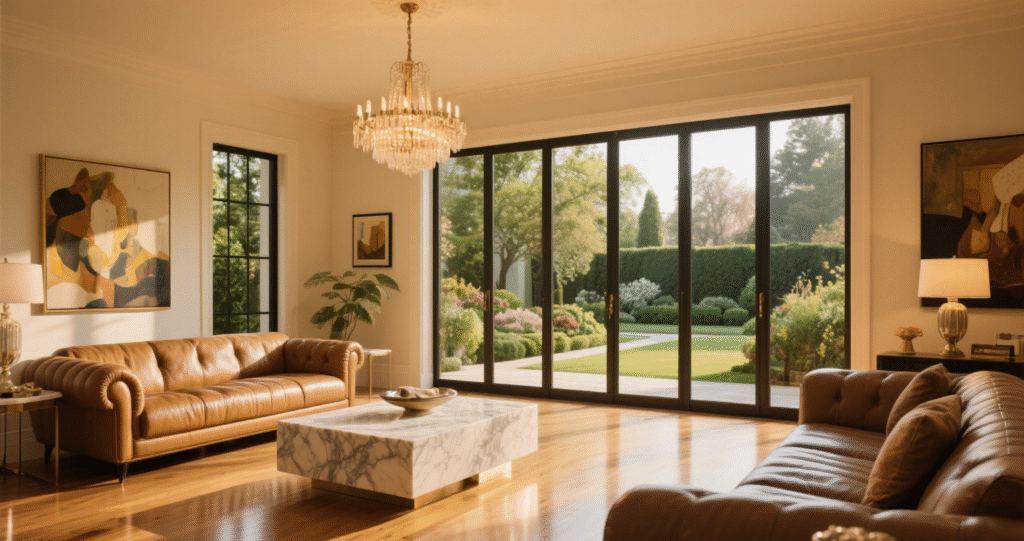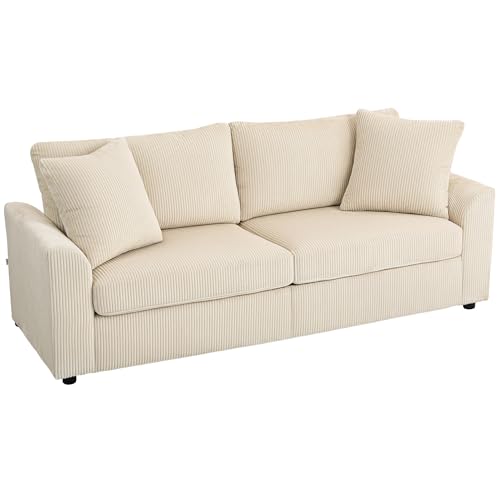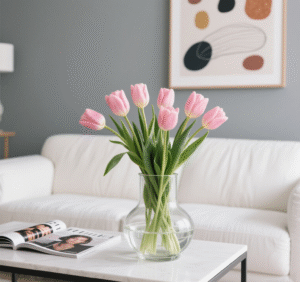This post may contain affiliate links which means we may receive a commission at no cost to you, if you make a purchase through a link. Please see our full disclosure for further information.
Do you ever walk into a home and instantly feel relaxed? Or maybe you’ve been in places that feel cold and stressful? It’s not just about luck. There’s a reason why some spaces make us feel good. It’s called biophilic design. This means using nature to create spaces that work with how our brains are wired.
It’s more than just adding plants. Keep reading to learn 12 ways to use biophilic design to make your home feel amazing.
Bring the Outside In
A View for Your Eyes
Looking at nature makes us feel better. Studies show that seeing nature, even in pictures, lowers blood pressure and heart rate. This makes sense because humans used to live outdoors, running from danger and finding food. Our brains connect nature with safety and survival.
You don’t have to move to the jungle to get these benefits. Small changes can help:
- Maximize your window views: Arrange furniture to face windows with trees, sky, or other natural elements.
- Use mirrors: If you have small windows, place mirrors near them to reflect light and greenery.
- Add nature-inspired art: Choose pictures of forests, landscapes, or flowers instead of abstract art.
Sounds for Your Brain
Natural sounds can lower stress levels. Bird songs, flowing water, and rustling leaves can be calming. City noises, on the other hand, can drain your energy.
To bring nature’s sounds into your home:
- Open your windows: Let in the sounds of birds and other animals.
- Play nature sounds: Use a sound machine or app to play recordings of rain, forests, or oceans.
Scents for Your Nose
Certain scents from nature can help us relax and focus. Studies have found that forests release chemicals that make us feel happy.
Here’s how to add natural scents to your home:
- Open your windows: Let in fresh air, if the air quality is good.
- Use real plants: Keep herbs in your kitchen or use an essential oil diffuser with scents like pine or lavender.
- Add natural materials: Use dried wood or citrus peels for a subtle fragrance.
Texture and Touch
Our ancestors constantly touched things in nature. They needed to know how things felt to survive. Wet stones could be dangerous, while dry ground was safe to walk on.
When you touch wood, stone, or linen, you trigger those old feelings of safety and familiarity.
- Use real materials: Choose clay vases over plastic ones.
- Pick wood over glass: If you’re deciding between a glass or wood dining table, choose wood.
Non-Rhythmic Stimuli
Imagine you’re staring at a computer screen all day. Your eyes are tired. Then, you look outside and see a bird fly by or sunlight move across the room. For a moment, your brain snaps out of focus. It’s a nice break.
This is called non-rhythmic sensory stimuli. Your brain likes random bits of nature happening in the background. Even a quick look at leaves moving or a pet playing can reset your brain.
- Work near a window: You might get distracted, but you’ll feel better.
- Add features that mimic natural movement: Use curtains that move in the breeze or keep pets that move around.
Why We Like Water
People love water. The sight and sound of moving water can hold your attention without tiring you out. This is called soft fascination.
There’s also a survival reason why we like water. Humans evolved near water sources. Water meant cooking, drinking, cleaning, and survival.
- Decorate with water: Use artwork or photographs with water in them.
- Add water features: Use a water bowl with floating candles, or small tabletop water plants.
- If you have outdoor space: Add a small fountain or bird bath.
Light That Moves
Most buildings use even, consistent lighting. But nature doesn’t work that way. Our brains love moving light. Sunlight flickering through leaves or reflections on a wall are like soft fascination for your brain.
- Maximize natural light: During the day, let in as much natural light as possible.
- Layer your lighting: In the evening, use multiple light sources like table lamps and floor lamps instead of relying on overhead lights.
Shifting of Color
Natural light changes throughout the day. Morning light wakes you up. Midday light keeps you alert. Evening light helps you relax.
- Use smart light bulbs: Install bulbs that change color temperature throughout the day to match natural light.
Living With the Seasons
Most of us live in climate-controlled homes. The changing seasons don’t really affect us. This disconnect can be a problem. Before clocks, we relied on nature to know when to plant crops or when animals would move.
- Use seasonal decor: Use light linen cushions in summer and cozy wool in winter.
- Plant seasonal greenery: Use climbing vines or plants that change with the seasons in outdoor spaces.
- Let materials age: Don’t keep everything in your home looking brand new. Let natural materials like wood and stone show their age.
Biomorphic Design
Look at two spaces and how their materials flow. Which one do you like more? If you want to feel good, you’ll probably choose the more organic space.
Most modern buildings use straight lines and sharp angles. But nature gives us curves, spirals, and branching forms. When we see these shapes, our brains recognize them as familiar and comforting. This is biomorphic design.
- Use curved furniture: Swap sharp-edged furniture for softer, curved pieces.
- Choose nature-inspired patterns: Use fabrics, wallpapers, or rugs with floral, leaf-like, or wave-inspired patterns.
- Incorporate natural architectural elements: If you’re building or renovating, add arched doorways, curved staircases, or windows with soft, organic shapes.
A Balance of Complexity and Chaos
Look at two rooms. Which one seems more inviting? Most people would say the one with more patterns and textures.
One reason is the presence of fractals. Fractals are repeating patterns that show up at different scales, like the branches of trees or the veins of a leaf. Our brains find them visually pleasing because they echo the logic of nature.
- Choose natural materials with visual complexity: Use a walnut table with swirling patterns or a marble surface with strong veining.
- Add plants and greenery: Use plants with branching forms and patterned leaves like ferns.
- Choose textiles and wallpaper with organic repetition: Use prints with floral designs, tree branches, or wavy lines.
Jay Appleton’s Theory Explained
Imagine you walk into a cafe. There’s a table in the middle of the room, a cozy booth in the corner, and a window seat in the corner with a view. People will usually pick the booth or the window seat, not the table in the middle.
People like to see what’s happening around them without feeling exposed. This is called prospect in environmental psychology. People feel more comfortable in spaces that let them see into the distance.
- Use internal glass doors: If you have doors between rooms, use glass doors to give you a view throughout the home.
- Arrange furniture to maximize views: Position chairs and sofas so you can see what’s going on around you.
- Combine prospect with refuge: Create a cozy corner where you can look out while feeling safe and tucked away.
Create Your Feel-Good Home Today
By using these 12 ideas, you can create a home that works with your brain and makes you feel amazing. So, take some time to bring nature into your space and enjoy the benefits of biophilic design.
Ready to transform your space? Start with one small change today and see how it makes you feel!
5 Star Hotel Interior Design Ideas & More!
A Guide to Hotel Design Pt 11: Bedroom Standards
5-star luxury hotel: what are the requirements?
Uncover further inspiration in our blog.










































